
Special Report : 56th Rescue Squadron - Aviano AB
56th RESCUE SQUADRON - AVIANO AB, Italy
Report and photos by Renzo Del Bianco
THE 56th RESCUE SQUADRON AT AVIANO AB
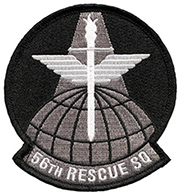
In 2018, the 56th Rescue Squadron, operating the Sikorsky HH-60G Pave Hawk, and 57th Rescue Squadron “Guardian Angels” moved from RAF Lakenheath, United Kingdom, to Aviano AB, Italy, joining the 31st Operations Support Squadron, 510th Fighter Squadron, 555th Fighter Squadron and 606th Air Control Squadron in the 31st Operations Group / 31st Fighter Wing already based there. The 56th and 57th squadrons represent the only Search and Rescue units in the U.S. Air Forces Europe and Air Forces Africa command.
According the official fact sheets, the 56th Rescue Squadron “provides a rapidly-deployable, worldwide combat rescue and reaction force response utilizing HH-60G Pave Hawk helicopters. The 56th RQS integrates with the Guardian Angels weapon system and other special forces to support insertion, extraction and recovery of both U.S. and allied combatants. The squadron offers long-range rescue, humanitarian assistance, non-combatant evacuation and disaster relief capabilities for USEUCOM, USAFRICOM and NATO in peacetime, contingency and wartime operations”, and the 57th Rescue Squadron “leads, organizes, trains and equips Guardian Angel weapons system and combat support teams to conduct day and night personnel recovery operations in combat, as well as to provide combatant commanders with options to report, locate, recover and reintegrate isolated personnel. Additionally, the 57th RQS provides personnel recovery, combat search and rescue, civil search and rescue and casualty evacuation subject matter experts to fulfill USEUCOM, USAFRICOM and NATO security cooperation requirements”.
For the first time since the re-alignment at Aviano AB, Italy, June 14, 2018, a media flight has been authorized with the purpose of documenting the training activity usually carried out by of the 56th Rescue Squadron. At the “reception desk” close to the 56th Rescue Squadron building's main door, we met the 1st Lt. Broussard, our escort in the 56th RQS tour, who gave us the welcome on behalf of the squadron Commander. Before to be briefed about the flight, we went to the vest room where we were assigned the ear protective headphones, with mic to communicate with the aircrew during the flight if needed, and the harness with safety strap that would secure us to the special hook on the cabin floor of the helicopter when in flight.
Briefing followed immediately after, and Capt. Jackson Bristol (aircraft commander for the mission) described the flight we would have aboard of a 56th Rescue Squadron HH-60G Pave Hawk. It would be a typical training flight with some approaches to three different locations and simulate personnel recovery with the cable at two of these, one at sea level and one at altitude in the mountains. In order to give us the opportunity to document the simulations, the HH-60 would land so we could disembark. According the flight plan: “Take-off from Aviano AB, at 16:30, direction south, until the coast of the Adriatic Sea. Simulated approaches to the Nicelli Airport at the Lido of Venice, first disembark on the dry and sandy bed of the Tagliamento River, in the Friulian plain, second disembark at altitude on a mountain zone, called Malga Slenza, near Pontebba, not far to the Italian- Austrian border. Come back to Aviano AB and landing about 19:35”.
After the aircraft commander’s talk, we clearly understood the importance of carrying out a double personnel recovery simulation. “Flight crews must be trained to operate in a variety of environments, day and night, with good or bad weather conditions. Performing approaches, landings and take-offs at sea level or at altitude is quite different, first of all for different power that the engines can give, since it decreases with altitude. Flying in open spaces such as in the plains or within a mountainous valley with gusts of wind involves a different commitments for the flight crews. For these reasons the squadron usually train the personnel recovery in different assigned areas, situated at sea level on the bed of the Tagliamento or Cellina-Meduna rivers and over mountain in the Alps. If instead the recovery training missions have to be carried out on the water, there is a wide maritime area off the Veneto – Friuli coast in the Adriatic Sea”.
The HH-60G rescue equipment includes a hoist capable of lifting a 600-pound load (270 kilograms) from a hover height of 200 feet (60.7 meters), and a personnel locating system that is compatible with the PRC-112 survival radio and provides range and bearing information to a survivor's location. Pave Hawks are equipped with an over-the-horizon tactical data receiver capable of receiving near real-time mission update information. It also has a cargo hook with a capacity of 8,000-pound (3,600 kilograms).
The conversation then followed on several different aspects of the squadron’s activity and helicopter characteristics. “Aircrew in the HH-60G “Pave Hawk” is usually four; pilot, co-pilot, a combination of two other aviators, such as aerial gunner and flight engineer. The 56th Rescue Squadron also works with Pararescue Jump (PJ) personnel from the 57th Rescue Squadron sister unit, for insertion and recovery missions when we need the “boots on the ground”. Usually three or four PJs are embarked on the Pave Hawk and they can get to the ground in different modalities from the HH-60; by jump at high altitude, by a multiple coiled rope from both side of the heli while hovering, and of course, when the helicopter lands”.
The HH-60G Pave Hawk is a highly modified version of the standard US Army UH-60 Blackhawk. It features upgraded communications and navigation suite that includes integrated inertial navigation/global positioning/Doppler navigation systems, satellite communications, secure voice, and Have Quick communications. All HH-60Gs have an automatic flight control system, with night vision goggles compatible lighting. and forward-looking infrared system that greatly enhances night low-level operations. Additionally, Pave Hawks have color weather radar and an engine/rotor blade anti-ice system that gives the HH-60G an adverse weather capability. To achieve further extension in autonomy, the G model is equipped with a retractable in-flight refueling probe and of two additional fuel tanks in the rear part of the cabin. Night and day in-flight refueling with HC-130, which can deploy to Aviano AB from different U.S. Air Force, U.S. Reserve Air Force or Air National Guard units, are frequently carried out by the aircrews of the 56th Rescue Squadron”.
“The HH-60G can be equipped with armament for regular training needed for aerial aviators to meet required combat skills and aerial gunnery certification. This kind of training has to be carried out outside Italy, because there are no specific ranges available in Italy at a fair distance from Aviano AB. For this reason, the 56th RQS conducts regular training at the Pocek range, near Postojma, in Slovenia and at the Croatian Army range “Eugen Kvaternik”, in Slunj. The gunners usually fire the GAU-2 B/A (7.62 mm with a 2,000-4,000 rounds for minute fire rate) at the Slovenian range, and the .50 inch (12,7mm) GAU-18 machine gun at the Croatian range”.
To improve air transportability and shipboard operations, all HH-60Gs have folding rotor blades. This is particularly helpful when the squadron deploys outside Europe. Recent deployment was to CENTCOM area of responsibility, where the squadron flew both the primary mission, Combat Search and Rescue (CSAR) and secondary one, Joint Personnel Recovery. The 56th Helicopter Maintenance Unit (HMU) personnel is always jointly involved alongside the aircrews of the 56th RQS to ensure HH-60Gs are always ready to take off at a moment’s notice. Pave Hawk combat enhancements are very helpful in hostile areas, these include a radar warning receiver, infrared jammer, and a flare/chaff countermeasure dispensing system.
After more than 30 years in service, the G model could be said to be looking a little aged. The transition in the U.S. Air Force inventory to the brand new HH-60W “Jolly Green II” has been started in 2020, when the first delivery of two HH-60W to the 41stRQS / 347th Wing took place at Moody AFB, Georgia. The Aviano team is confident to receive the W model in 2025, meanwhile the 56th Rescue Squadron / 31st Fighter Wing will continue to operate the “AV” tail coded HH-60G Pave Hawks and train the assigned aviators in European theater and all TDY areas of destination, according the moto: “TRAIN TODAY, TO PREPARE FOR TOMORROW”.
“JOLLY ONE-ONE, READY TO GO” - HH-60G training flight
At 16:30, the HH-60G serial 89-26212, lifts off a few meters over the light grey tarmac of the parking area assigned to the 56th Rescue Squadron, and begins to move along the taxiway north until the first cross way to position on the runway. All aircraft take off and land at Aviano AB from the runway 05 (toward east) or 23 (toward west). Pilot to control tower: “Jolly one-one, ready to go”, control tower to pilot, “cleared for take off, runway 05”. The 56th RQS’s HH-60G Pave Hawk begins the scheduled training flight, climbing to the assigned altitude and reaching the cruise speed, in southern direction towards the Adriatic Sea coast. As it got to the coast, a 90 degrees turn right aligns the HH-60G with the sandy white beaches lining the coast until the Venice laguna, where the destination is the small airfield of the Lido of Venice, named after Sergeant Pilot Giovanni Nicelli, World War I ace with 8 kills, to execute some approaches to the 994 meters grass runway training the aircrew in the procedures and safety rules concerning maneuvers onto unfamiliar airfields.
The next leg over the Venetian and Friulian plains takes us to a specific zone of the Tagliamento river where the personnel recovery simulation with cable is to be executed. In order to document the scheduled activity, we disembark from the heli and reach a safety position from where to take pictures when the HH-60 approaches and see the flight engineer operating the winch device over the selected recovery position to simulate the operation.
After the simulation and boarding us again, a second half an hour flight takes us to a mountain zone not far from the Italian-Austrian border, on a peak at an altitude of almost 1600 meters, close to Pontebba town. Training at altitude is of great importance because of the progressive power reduction of the helicopter engine as height increases, so the crews have to be fully trained within this environment as well. Once disembarked again, we can document the new personnel recovery simulation in that wonderful mountainous setting.
The last part of the flight prosecutes with further simulated approaches to different narrow grassy strips on the peaks of the mountain area. About three and a half hours after take-off, the grey tail-code “AV” HH-60G, serial 89-26212, returns at Aviano AB and parks at the hot-pit refueling dedicated area, where a new flight crew is waiting for a second scheduled sortie with the helicopter. Tired, but fully satisfied of the experience and achieved photos, we thanked the crew for sharing with us what a regular training mission for the men and women of the 56th Rescue Squadron encompasses.
56th Rescue Squadron history
Constituted as 56th Air Rescue Squadron on 17 October, 1952, the was activated on 14 November, 1952, at Sidi Slimane AB in French Morocco, with the flight component including Sikorsky H-5s and Grumman SA-16 Albatrosses. The H-5 was soon replaced by the Sikorsky SH-19 Chickasaw. The unit flew search and rescue, and medical evacuation missions both in North Africa and Southern Europe from November 1952 until March 1960, when the unit was inactivated. The history of the 56th resumed at Korat RTAFB, Thailand, where it was re-activated on 8 July 1972, and then re-designated to 56th Aerospace Rescue and Recovery Squadron two days later. In the Southeast Asia combat theater, the squadron flew HC-130P (call sign King) and Kaman HH-43F Huskie (call sign Pedro) and performed search and rescue (HH-43F), airborne mission control and aerial refueling (HC-130P) until August 15, 1975, date of inactivation. Unfortunately, the Huskie helicopter didn’t have an air refueling probe, so its action radius was limited to operation within 75 nautical miles of its base, so its primary mission was Local Base Rescue (LBR). In Korat RTAFB one HH-43F always stood ready on 24 hour ground-alert status. For the campaign in Southeast Asia, the 56th ARRS gained a Presidential Unit Citation, a Republic of Vietnam Gallantry Cross with Palm, and several Air Force Outstanding Unit Awards.
The squadron was re-activated on 1 May 1988, at the NAS Keflavik, Iceland, and was re-designated 56th Air Rescue Squadron on 1 June 1989. It received the Sikorsky HH-3E Jolly Green Giant that had already been operated at NAS Icelander from November 1971 by the 39th Air Rescue and Recovery Wing, Det.14. The new helicopter provided the 56th ARS a longer range of action, so that the squadron was able to support the Iceland Defence Force and NATO components in search and rescue over an extended area ranging from Iceland to the North Pole. In 1992, the HH-3s were replaced by the new Sikorsky HH-60Gs Pave Hawk. The unit designation changed to 56th Rescue Squadron from February 1st, 1993. On 1 June 2006, the squadron relocated to RAF Lakenheath, United Kingdom, from where it would have executed Combat Search and Rescue (CSAR) missions in support of USAFE. In June 2018, the unit moved to Aviano AB, Italy, to join the 31st Operation Group / 31st Fighter Wing. In advance to the relocation, the 56th RQS first deployed to Aviano AB with purpose to familiarize in local procedure and new environment, carrying out flights with Italian Air Force 15°Stormo’s HH-101s from Cervia Air Base. The re-alignment ceremony of the 56th and, sister unit, 57th Rescue Squadron, took place June 14, 2018. The 31st Operations Group Commander, Col. Richard Nelson, presided over the ceremony of both squadrons realigning to the 31st Fighter Wing, Italy. In front of Airmen, families and guests, the commander at the time, Lt. Col. Leslie Semrau, reaffirmed responsibility of command for 56th Rescue Squadron and, the commander at the time, Maj. Seth Davis, reaffirmed responsibility of command for the 57th Rescue Squadron. A new chapter in the prestigious history of the 56th Rescue Squadron is now underway at the Aviano AB, the only U.S. Air Forces Europe and Air Forces Africa main air base south of the Alps.
We thank the 56th Rescue Squadron and the aircrew of the HH-60G in allowing us to share what they usually do to train in the assigned missions. A special thanks to Mrs. Angela Zammattio, 31st Fighter Wing / Public Affairs, for making this article possible.
Additional Sources : U.S. Air Force Fact Sheets; AFHRA Fact Sheets, 31st Fighter Wing / Public Affairs Office releases.
Report and photos by Renzo Del Bianco ( view portfolio )
Last Modified: 15 May 2022





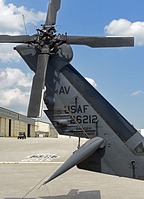




































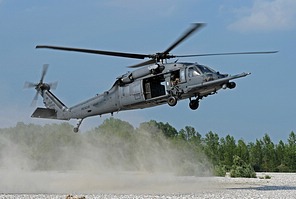






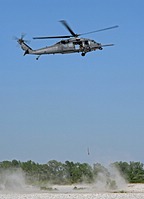








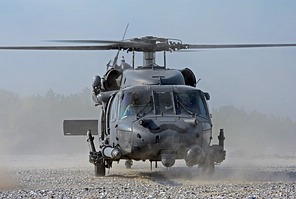






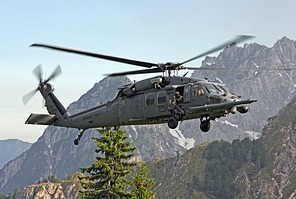

















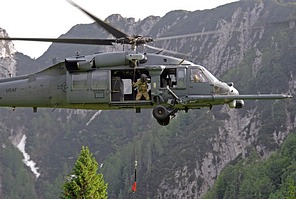
















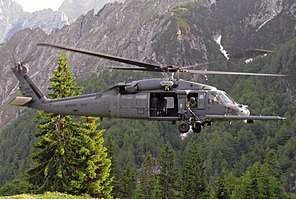














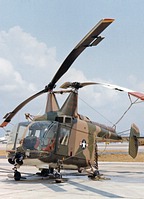















 Back to Index
Back to Index